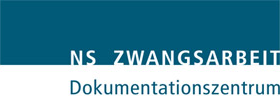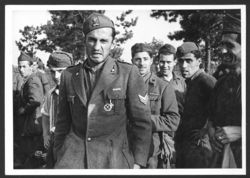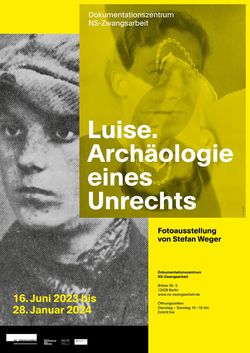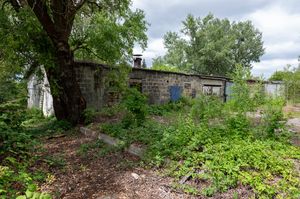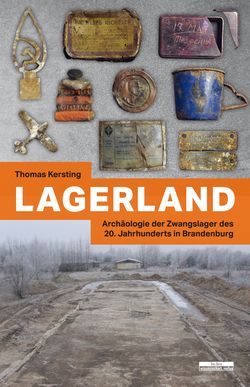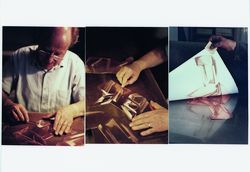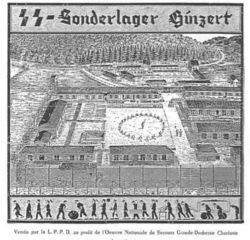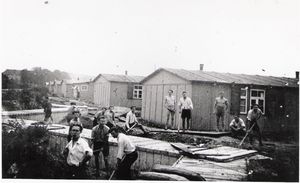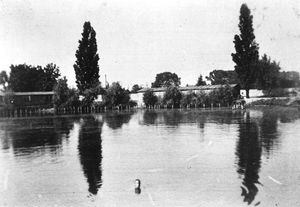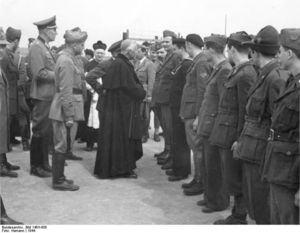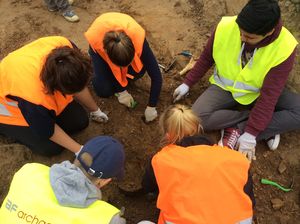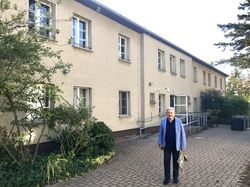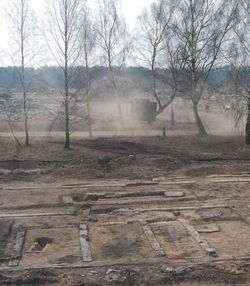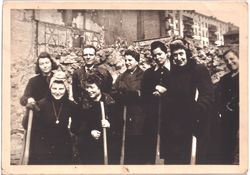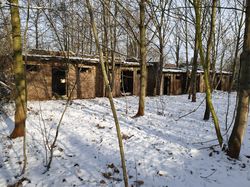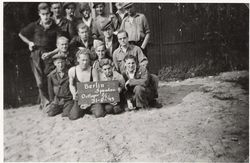2023
Italian military internees - 80th anniversary
Lecture evening and panel discussion
7 September 2023 | 7 p.m.
On September 8, 1943, the armistice between Italy and the Allies is announced. As a result, the Germans deport hundreds of thousands of Italian soldiers, about 50,000 do not survive captivity. On the 80th anniversary, this event focuses on the events and their consequences.
As Italian military internees, the Nazis refer to Italian soldiers who, after September 8, 1943, refuse to go into the world war on the side of the German Wehrmacht and the fascist Italian Social Republic. They are deported to Germany and have to perform forced labor. For a long time, no one in Germany or Italy remembers this story. Today, mainly their families as well as some museums and initiatives are dedicated to the memory of their fates.
Welcome:
Christine Glauning | Director Documentation Center Nazi Forced Labor.
Lectures:
Prof. Brunello Mantelli | University of Turin
Prof. Nicola Labanca | University of Siena
Virgilio Comberlato | Relative of a survivor
Commentary: Daniela Geppert | Documentation Center Nazi Forced Labor
This will be followed by a panel discussion.
Moderation: Dr. Sara Berger | Fritz Bauer Institute Frankfurt am Main
The event will be held in Italian and German (simultaneous translation).
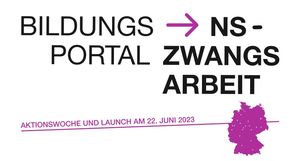
Launch of the "Nazi Forced Labour Education Portal" website
22 June 2023 | 7 pm
The digital "Educational Portal Nazi Forced Labour" bundles historical information and educational materials. It is the result of cooperation between 19 places of learning and remembrance under the coordination of the Nazi Forced Labour Documentation Centre.
On the occasion of the portal's launch on 22 June 2023, experts will discuss educational work on Nazi forced labour that is relevant to the present. A nationwide action week from 19-25 June 2023 offers the opportunity to get to know the diverse educational offers at the respective places of remembrance. Please find the programme of the action week in the attached PDF.
Around 13 million people who were deported to Germany had to perform forced labour in all sectors of the German economy between 1939 and 1945. Their everyday life was marked by a strict racist hierarchy. Dealing with the history of Nazi forced labour is central to understanding National Socialism and sharpens the view of current conditions in which people are exploited and marginalised.
Welcome:
Daniela Geppert
Nazi Forced Labour Documentation Centre
Presentation of the educational portal:
Lisa Schank
Nazi Forced Labour Documentation Centre
Panel discussion: Contemporary relevance of education on Nazi forced labour
Anna Domdey
Breitenau Memorial
Ksenja Holzmann
Bunker Valentin Memorial
Oliver Nickel
Memorial Stalag 326, Senne
Martina Staats
Memorial in the JVA Wolfenbüttel
The event will be streamed live on our YouTube-channel.
Exhibition opening: Luise. Archaeology of an injustice
A photo exhibition by Stefan Weger
15 June 2023 | 7 pm
"You know that was Luise?"
Fałków, 1941. 15-year-old Pole Walerian Wróbel is deported to Bremen for forced labour. He has language problems and is homesick. After 10 days, Walerian sets fire to the house because he hopes he will then be sent home. The farmer's wife Luise has him picked up by the Ge stapo. Walerian is taken to Neuengamme concentration camp and executed on 25 August 1942. Luise was the great-grandmother of photographer Stefan Weger.
With this exhibition, Weger confronts his family history, which is interwoven with National Socialism. He calls his photographic-artistic project on the death of the young forced labourer "Archaeology of an Injustice". Weger searched for family photos, explored the overgrown area around the old farm and collected files on the case. The result is a dense visual portrait of a family history under National Socialism that revolves around forgetting and raising awareness.
Stefan Weger: The editor, portrait and documentary photographer lives and works in Berlin. In 2021 he graduated from the Ostkreuzschule für Fotografie in Berlin-Weißensee. In his personal long-term projects, Weger focuses on larger social and, above all, historical themes. In these, he uses the approach of research-based photography, as in this photo exhibition. The photo book on "Luise. Archaeology of an Injustice" was awarded the German Photo Book Prize in Gold in 2021.
Karya 1943. Deadly forced labour in Greece
History and topography of a crime scene
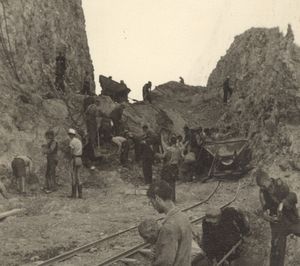
Little is known about the events in Karya. Therefore, investigations carried out on site by the Interdisciplinary Working Group Conflict Landscapes of the University of Osnabrück are important. Researchers and students searched for traces of forced labour in the vicinity of the former OT construction site from 1943 and documented the crime scene.
Methods and the digitally processed results of the site investigation in Karya are presented by means of animations and digital models. Experts on German-Greek history will speak about the significance of these new findings and the common memory of this site of Jewish forced labour.
In 1943, around 300 Jewish forced labourers from the Thessaloniki ghetto were forced to build an alternative track in the rocks along the railway line between Thessaloniki and Athens. Many of them were quickly completely exhausted due to the inhumane work, hunger and violence and died on the spot.
Welcome:
Dr. Christine Glauning, Director of the Nazi Forced Labour Documentation Centre.
Greeting:
Dr. Andrea Despot, Chairperson of the Board of the Foundation Remembrance, Responsibility and Future.
Lectures
Dr. Iason Chandrinos, Nazi Forced Labour Documentation Centre:
Karya - Persecution of Jews and Forced Labour in Greece 1942-1943
Lukas Hennies/Christoph Rass, University of Osnabrück: The Research Prospect in Karya of the Interdisciplinary Working Group Conflict Landscapes - Methods, Findings, First Results
Comment
Dr. Kateřina Králová, Head of the Research Centre for Memory Studies, Charles University Prague.
Moderation
Dimitra Kyranoudi, correspondent of Deutsche Welle in Berlin
On the future of the historic site
Panel discussion
4 May 2023 | 7 pm | An event in cooperation with rbb24 inforadio.
The panel discussion is dedicated to the status of planning and future perspectives for the historic camp site on Landweg in Lichterfelde.
In 2017, various civic initiatives discovered that barracks of a Nazi prisoner-of-war camp were located on the site. Three years later, the State Monuments Office and the Groth Group, the owner of the site, agreed to preserve the building at Landweg 3/5a and the foundations of a guardhouse. What is to be done on site now?
The event is the finissage for the exhibition "Forgotten and over? The Lichterfelde Camp and the French Prisoners of War", which can be seen at the Nazi Forced Labour Documentation Centre until 31 May 2023.
Greeting:
Dr. Christoph Rauhut | State Conservator, Director of the State Office for the Protection of Monuments.
Panel:
Dr. Christine Glauning | Nazi Forced Labour Documentation Centre, Director
Michael Karnetzki | District of Steglitz-Zehlendorf, City Councillor for Urban Development
Anette Mischler | Groth Group, Press Spokesperson
Thomas Schleissing-Niggemann | Initiative KZ-Außenlager Lichterfelde e.V., Chairman
Moderation:
Harald Asel | rbb24 Inforadio
At 6 p.m. there will be a curator's tour of the exhibition "Forgotten and Over?
Book launch: Thomas Kersting | Lagerland
Archaeology of the Forced Camps of the 20th Century in Brandenburg
20 April 2023 | 7 pm
The 20th century is rightly called the century of camps. Two concentration camps, three large prisoner-of-war camps, several hundred subcamps and even more "civilian" forced labour camps and other camps were located in the area surrounding the former capital of the Reich, Berlin, now the state of Brandenburg. For over 25 years, the task of archaeology has been to track down these often forgotten places, to research their material remains, to preserve them as monuments and places of (spiritual) memory, and at the same time to enable new access to them. Access to the people imprisoned there is made possible by the countless finds: they speak for the now dying generation of contemporary witnesses. They testify to both individual fates and mass crimes in the 20th century: against any attempt at relativisation and denial. The research of the recent past by means of archaeology is exemplarily demonstrated here for the first time for a German federal state. (From the book description)
Book presentation: Dr. Thomas Kersting
Head of the Department for the Preservation of Archaeological Monuments at the Brandenburg State Office for the Preservation of Monuments and the State Archaeological Museum
Commentary: Dr. Juliane Haubold-Stolle
Berlin Wall Foundation, curator of the exhibition "Exclusion.Archaeology of the Nazi Internment Camps".
Moderation: Kathrin Misterek
Archaeologist
Artist talk with Heribert Bücking
25 March 2023 | 3 pm
Heribert Bücking shows copperplate collages in the exhibition "The Forced Labour of Zofia and Rolland".
In conversation, Heribert Bücking will talk about the exploration of the topic of forced labour and the search for the appropriate pictorial form. The project was triggered by documents on the forced labour of Zofia Pytkowska and Rolland Mazaud, which their son Philippe had made available to him.
The following questions were at the forefront: "In view of the barbarity of Nazi forced labour as shown in the Documentation Centre ... Does the visual arts have anything to report at all? Or is it perhaps works of art that can inspire a new view of the monstrous scenarios? ... Is there a bridge between such documents and the attempt to find a pictorial interpretation, a symbolic expression for what happened?"
The life-affirming message of Zofia and Rolland, who met and fell in love during forced labour in Berlin, has accompanied the artist in his work. It is a special form of commemorating Nazi injustice.
Heribert Bücking, born in 1940, works in Berlin and is one of the few in Germany who still master engraving. His works have been shown in numerous solo exhibitions to date.
The "forbidden contact" in National Socialism and the "Germanisation procedure" in the special SS camp Hinzert
Panel discussion
23 March 2023 | 7 pm
The goal of the Nazi persecution apparatus was to keep contacts between the German population and "alien" forced labourers to a minimum.
Social contacts, especially sexual relations, were punished draconically even on mere suspicion. For Poles, the National Socialists developed a special procedure in individual cases: the "Germanisation procedure" based on racist criteria. The special SS camp Hinzert played a central role in this.
The 2023 anthology edited by Insa Eschebach, Christine Glauning and Silke Schneider "Verbotener Umgang mit 'Fremdvölkischen'. Criminalisation and
Criminalisation and the Practice of Persecution under National Socialism" brings together the latest research findings on the subject - including on the Hinzert special SS camp. The event will shed light on the persecution practice of "forbidden contact". The focus of the content is on the " Germanisation procedure" in the SS special camp Hinzert.
Welcome:
Dr. Christine Glauning
Director Nazi Forced Labour Documentation Centre
Moderation:
Dr. Sabine Arend
Director of the Hinzert SS Special Camp Memorial, Rhineland-Palatinate State Agency for Civic Education
Panel:
Dr. Beate Welter
former director of the memorial SS-Sonderlager/KZ Hinzert
Dr. Lena Haase
Research assistant at the University of Trier
Dr. Silke Schneider
Substitute professor of political science at Bielefeld University of Applied Sciences
Dr. Insa Eschebach
Visiting researcher at the Institute for Religious Studies at the FU Berlin, former director of the Ravensbrück Memorial Site
A stream and a recording of the event are in preparation.
French prisoners of war in Berlin
Camp, work and everyday life
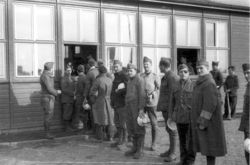
2 February 2023 | 7 pm
French prisoners of war were interned in Berlin for five years (1940-1945). Here they formed the largest group of prisoners of war until autumn 1943.
In addition to the large Lichterfelde and Falkensee camps, French prisoners of war were housed in hundreds of work detachments, spread throughout Berlin. In March 1941, the group numbered around 20,000 men. Most of them had to work.
Starting from the Lichterfelde camp, Thomas Irmer illuminates the group of French prisoners of war in Berlin in his lecture. Eva Kuby presents the magazine "Matricule X", which appeared in at least 50 issues from 1941 to 1945 and was aimed at French prisoners of war in Berlin.
Welcome: Dr. Christine Glauning
Head of the Nazi Forced Labour Documentation Centre
Overview lecture: Thomas Irmer
Historian, political scientist, expert on the history of Nazi forced labour
2022
Nazi forced labour on our doorstep
Series of events 12 Berlin districts, 12 events
80 years ago, in 1942, forced labour became a mass phenomenon in Berlin. As the war wore on, the German economy's need for labour grew immeasurably. In March 1942, the Nazi regime created a central authority, the "General Plenipotentiary for the Deployment of Labour", to organise the deportation of more and more people more efficiently. Hundreds of new accommodation camps were built in Berlin as part of the "Lagerbauaktion 1942".
The series takes a look at the individual Berlin districts in 12 events. What does this crime, which took place on our doorstep, have to do with our society today? And why did it take so long to come to terms with it? Lectures, readings, film screenings and discussions are planned as part of the series of events. The focus will be on places of forced labour that have only recently been "rediscovered".
Thursday, 20 January 2022, 6 pm
Charlottenburg-Wilmersdorf Museum, online
Thursday, 17 February 2022, 6 pm
Treptow-Köpenick Museums, Treptow-Köpenick Adult Education Centre, Baumschulenstr. 79-81
Thursday, 17 March 2022, 6 p.m.
Museum Reinickendorf, Alt-Hermsdorf 35
Thursday, 7 April 2022, 6 p.m.
Citadel Zitadelle, Am Juliusturm 64
Thursday, 19 May 2022, 6 pm
Mitte Museum, Pankstr. 47
Thursday, 16 June 2022, 6 p.m.
FHXB Friedrichshain-Kreuzberg Museum, Adalbertstr. 95A
Thursday, 14 July 2022, 6 p.m.
Tempelhof Schöneberg museums, information point heavy load body, General-Pape-Str. 100
Thursday, 25 August 2022, 6 p.m.
Department of Culture Steglitz-Zehlendorf, Schwartzsche Villa, Grunewaldstr. 55
Thursday, 22 September 2022, 6 p.m.
Museum Pankow, Prenzlauer Allee 227-228
Thursday, 20 October 2022, 6 p.m.
Marzahn-Hellersdorf District Museum, Alt-Marzahn 51
Thursday, 17 November 2022, 6 p.m.
Museum Neukölln, Alt-Britz 81
Thursday, 8 December 2022, 6 p.m.
Museum Lichtenberg, Türrschmidtstr. 24
Nazi Forced Labour in the Berlin Districts - Part 12
Lichtenberg: Places of Nazi Forced Labour and Commemoration
8 December 2022 | 7 pm | Museum Lichtenberg
Nazi forced labour was also omnipresent in Lichtenberg. In addition, institutions of forced labour of supra-regional importance were located in the district.
In Lichtenberg, forced labour took place both in well-known industrial companies, e.g. Knorr-Bremse, and in agriculture. The Rummelsburg workhouse in the district was an institution that had already practised forced labour in the Empire. The Wuhlheide "labour education camp" (Arbeitserziehungslager) played a key role in the persecution of forced labourers in Berlin.
Examples of places of forced labour and persecution are the focus of Thomas Irmer's lecture on the profile of Nazi forced labour in Lichtenberg. Roland Borchers will present current forms of commemoration.
Welcome and moderation: Anna Maria Katz
Head of the Department of Museum and History / Museum Lichtenberg
Greeting: Dr. Christine Glauning
Director of the Nazi Forced Labour Documentation Centre
Overview lecture: Thomas Irmer
Historian, political scientist, expert on the history of Nazi forced labour
Commemoration: Roland Borchers
Nazi Forced Labour Documentation Centre
The Stalag III D
Prisoners of war in Berlin
Thursday, 1 December 2022, 7 pm
The event presents new research on the Berlin prisoner of war camp Stalag III D, about which little is known so far.
The Wehrmacht founded Stalag III D in August 1940 with the establishment of the Lichterfelde camp. Further camp locations were established in Falkensee, Kaulsdorf, Friedrichsfelde and Großbeeren, among others. In addition, there were hundreds of other work detachments, most of which were also housed in camps.
French prisoners of war formed the largest group in Stalag III D for a long time; this is the subject of the exhibition "Past and Forgotten?" From 1943, the Wehrmacht brought over 30,000 Italians to Berlin. It is little known that there were also over 10,000 Soviet prisoners in Stalag III D.
Welcome address: Dr. Christine Glauning
Head of the Nazi Forced Labour Documentation Centre
Greeting: Dr. Heike Winkel
German War Graves Commission (Volksbund Deutsche Kriegsgräberfürsorge e.V.)
Overview lecture: Barbara Schulz
Office for Contemporary History and Monument Preservation
Italian military internees: Arne Pannen
Sachsenhausen Memorial and Museum
Soviet prisoners of war: Kolja Buchmeier
Brandenburg Memorials Foundation
Chair: Dr. Babette Quinkert
Museum Berlin-Karlshorst
At 6 p.m. there will be a curator's tour of the exhibition "Past and Forgotten? The Lichterfelde Camp and the French Prisoners of War" will take place.
The permanent exhibition will be open until 7 pm.
Event Series Part XI: Neukölln
Workshop discussion on the memorial lab at the Clay School
Thursday, 17 November 2022 | 6 pm
Venue: Festsaal Schloss Britz, Alt-Britz 73, 12359 Berlin
The Clay School in Rudow is being rebuilt on a former camp site. Its history is to be integrated into the new building as a memorial laboratory.
The accommodation camp existed from 1941 to 1945. A few years ago, the last remaining barrack was demolished. In 2014, an archaeological excavation was carried out on the site with the participation of students.
Material legacies are becoming increasingly important for dealing with the Nazi era. This development will be taken into account in the new school building by exhibiting finds from the camp grounds in the memorial laboratory. The workshop discussion will provide an insight into the state of planning.
Greeting: Dr. Christine Glauning
Director of the Nazi Forced Labour Documentation Centre
Introduction and moderation: Dr. Matthias Henkel
Director of the Museum Neukölln
Panel:
Brigitte Fischer | Staab-Architekten office
Silvia Haslauer | Museum teacher / Albert Einstein School
Philip Hefke | Museum teacher / Fritz-Karsen-Schule
Niels Plaumann | Clay School, Head of Department
Marisa Schulz | Museum Neukölln
Lothar Semmel | former deputy head of the Clay School
A 12-part series of events in cooperation with the Berlin Regional Museums (January-December 2022).
Einladung
Nazi Forced Labour in the Berlin Districts - Part 9
Pankow - Nazi Forced Labour and the Health Service
22 September 2022 | 6 pm | Museum Pankow - Cultural and Educational Centre Sebastian Haffner
Health care was a key moment in the system of Nazi forced labour. It was here that extreme Nazi racism was revealed.
Health care and the forced labour system overlapped in many areas: from fitness examinations in the home country and in transit camps to sickness collection and deportation camps to childbirth. Many forced labourers died in so-called hospitals for foreigners.
Bernhard Bremberger illustrates the interfaces between health care and forced labour with selected examples from today's district of Pankow. Bernt Roder presents current memorial projects.
Welcome and presentation of current projects:
Bernt Roder, Director Museum Pankow
Greeting:
Dr. Christine Glauning; Director Documentation Centre Nazi Forced Labour.
Lecture:
Dr. Bernhard Bremberger; Historian
A 12-part event series in cooperation with the Berlin Regional Museums (January-December 2022).
The event will be recorded and made available on the Documentation Centre's YouTube channel.
Human Commodity | Ware Mensch
Ceremonial act and opening concert
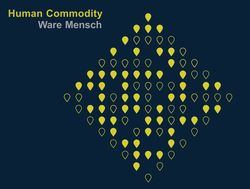
17 September 2022
A musical-documentary memorial by the Marc Sinan Company and the Nazi Forced Labour Documentation Centre.
Forced labour was a central component of the Nazi dictatorship. Between 1938 and 1945, around 13 million people had to perform forced labour in the German Reich. In Berlin alone, some 500,000 forced labourers were distributed throughout the city in around 3,000 camps and collective accommodation centres. At no time were so many people from other countries living in Berlin and forced to work.
The project "Human Commodity" uses an interactive app to commemorate 99 places of forced labour in Berlin and makes the stories of 99 forced labourers audible. In addition to central historical information, musicians present the pieces composed by Marc Sinan. The 99 audio miniatures are representative of all victims of Nazi forced labour.
The memorial will be presented in two parts for the first time on 17 September 2022. A ceremony will take place at the Nazi Forced Labour Documentation Centre at 2 p.m. - with lectures, music and guided tours of the grounds. In addition, the sound artist Kaffe Matthews will offer cycling tours with her 'Sonic Bikes', developed especially for the project.
In the Spreehalle Berlin you can experience a photo exhibition on Human Commodity from 5 pm and the opening concert by the Marc Sinan Company at 6 pm.
Open Monument Day
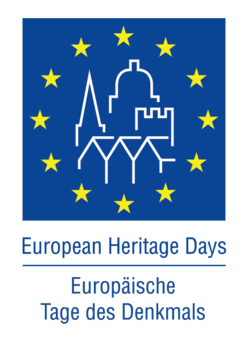
Saturday 10 September 2022
11 am Kiez Rundgang - NS Forced Labour in Schöneweide
13 am Tour of the exhibition on the Italian military internees and the grounds with barrack 13
3 pm Tour of everyday forced labour 1938-1945 and grounds
Sunday 11 September 2022
11 am Guided tour of the exhibition : Forced Labour in the Daily round and Barack 13 - in English
1 pm Guided tour : Sickness and Forced Labour
3 pm Guided tour Exhibition Everyday Forced Labour 1938-1945 and Grounds
Please allow two hours for all activities. No registration is required. We look forward to seeing you.
Nazi Forced Labour in the Berlin Districts - Part 7
Tempelhof-Schöneberg Nazi Forced Labour at Tempelhof Airport and in Mariendorf
14 July 2022 | 6 pm | Schöneberg Museum
Tempelhof was once an important industrial site in Berlin. During the Second World War, production was kept going by forced labourers.
Thousands of people had to perform forced labour for Lufthansa and Weser Flugzeugbau on the Tempelhof field. Traces of the accommodation camps were uncovered during archaeological excavations from 2012 to 2014. In her lecture, Kathrin Misterek provides insights into the excavation project and the dimensions of forced labour.
Miklas Weber has been dealing with Nazi persecution in Mariendorf for a long time. Two forced labour camps existed at the former Mariendorf freight station. In 1944, a Soviet forced labourer was shot there "on the run", and two others were deported to concentration camps. The area is currently being developed as the "Marienhöfe" project.
Welcome & moderation:
Philipp Holt, Deputy Director of the Tempelhof-Schöneberg Museums.
Greeting:
Dr. Christine Glauning, Director of the Documentation Centre Nazi Forced Labour.
Lecture:
Kathrin Misterek, archaeologist
Lecture:
Miklas Weber, neighbourhood researcher
On Saturday, 23 July 2022, Ms Misterek will offer a guided tour of Tempelhofer Feld at 4 pm. Registration: museum@ba-ts.berlin.de or 030 / 90 277 6163. The meeting point will be announced upon registration. A 12-part event series in cooperation with the Berlin Regional Museums (January-December 2022).
ARCHAEOLOGY OF CAMPS
THE MATERIALITY OF EXCLUSION
Workshop: 23-24 May 2022
Free University of Berlin
Hittorfstraße 18
14195 Berlin
Zygmunt Bauman called the 20th century the "century of the camps." This designation also applies to the first decades of the current millennium. There are still forced labour and refugee camps, military camps and camps for prisoners of war. The radical exclusion practiced by earlier forced labour and concentration camps is still found in camps today, albeit in other ways.
Camps are established for very different reasons. An important question to be addressed in this workshop is that of the commonalities and differences among them. Camps create a highly structured spatial order of exclusion but also determine to a large extent the materiality of internees' lives. Camp administrators strive to de-individualise incarcerated people. Material barriers limit their freedom of choice. Partitioning of space and control structures are among the best-known characteristics of camps, but the control of access to everyday things deserves equal attention.
The aim of the conference is to examine the materiality of camps as a central element of exclusionary practices both in the past and present. The conference will also address the possibilities and limits of comparability, both diachronic and synchronic.
Nazi Forced Labour in the Berlin Districts - Part 5
Mitte - Forced Labour of Berlin Jews and Forced Labour in Moabit
19 May 2022 | 6 am | Mitte Museum
The event offers an overview of Nazi forced labour in today's Mitte district and presents a current project from Moabit.
In his lecture, Thomas Irmer looks at the history of forced labour in Mitte. One focus is on "closed labour deployment", i.e. the forced labour of Berlin Jews, which he examines using the example of the electrical industry.
The initiative "Your Last Path" presents the project "Forced Labour in Moabit 1938-1945". As part of the event, it will open an exhibition at the Mitte Museum showing places of forced labour in Moabit.
Welcome & moderation:
Nathan Friedenberg, Director of the Mitte Museum
Greeting:
Dr. Christine Glauning, Director of the Nazi Forced Labor Documentation Center.
Lecture:
Thomas Irmer, historian, political scientist, expert on the history of Nazi forced labour and the electrical industry
Lecture:
Thomas Schöndorfer, initiative "Your last way" of the association "They were neighbours e.V.", Moabit
A 12-part event series in cooperation with the Berlin Regional Museums (January-December 2022).
A recording of the event can be found afterwards on the YouTube channel of the Documentation Centre.
Aircraft production and forced labour at Henschel
The first airport in Schönefeld
Wednesday, 27.04.2022 | 7 pm | online
The company operating Berlin's new airport, Flughafen Berlin Brandenburg GmbH, has commissioned scientists to research the history of Schönefeld Airport under National Socialism. As early as 1933, the Henschel company began building an airfield and aircraft factory there.
From 1936, Henschel produced aircraft under licence, and subsequently also its own aircraft. Remote-controlled missiles were also tested. After the beginning of the Second World War, an increasing number of forced labourers were employed. In 1943 there were more than 5,000 workers, mainly from the Soviet Union and Poland, who had to perform forced labour in the Schönefeld factory.
Prof. Christoph Bernhardt and Dr Stefanie Brünenberg describe the construction of the factory, but above all the working and living conditions of the forced labourers. Dr. Lutz Budraß, specialist in the history of Nazi aviation, moderates and comments.
Welcome: Dr. Christine Glauning, Director of the Nazi Forced Labor Documentation Center
Greeting: Sabine Deckwerth, Berlin-Brandenburg Airport GmbH
Lecture: Prof. Dr. Christoph Bernhardt, Leibniz Institute for Spatial Social Research, Humboldt University Berlin
Lecture: Dr.-Ing. Stefanie Brünenberg, Leibniz Institute for Spatial Social Research
Moderation: Dr. Lutz Budraß, Ruhr University Bochum
Nazi Forced Labour in the Berlin Districts - Part 4
Spandau
Thursday, 7 April 2022 | 6 pm | Stadtgeschichtliches Museum Spandau, Zitadelle
Many armament factories were located in Spandau, especially the Siemens Group. They employed forced labourers on a large scale.
In a panel discussion, four experts will discuss the dimensions of forced labour in Spandau and the state of reappraisal. As the recent debate on the occasion of the development of the former aviation equipment factory on Streitstraße illustrates, not all sites have yet been adequately researched. The discussion will also show that the surrounding area was also integrated into the Berlin forced labour system, for example the municipality of Falkensee.
Welcome & moderation:
Dr. Urte Evert
Director of the Stadtgeschichtliches Museum Spandau
Greeting:
Dr. Christine Glauning
Director of the Nazi Forced Labor Documentation Center
Panel:
Torsten Dressler
Archaeologist, building researcher and monument conservator
Gabriele Helbig
Director of the Falkensee Museum and Gallery
Uwe Hofschläger
Youth History Workshop Spandau
Florian Kemmelmeier
Topography of Terror Foundation
A 12-part series of events in cooperation with the Berlin Regional Museums (January-December 2022).
The event will take place in Spandau with an audience on site. A recording will be made available by the Documentation Centre on its YouTube channel.
Nazi Forced Labour in the Berlin Districts - Part 3
Reinickendorf - Nazi Forced Labour and the Use of Accommodation Camps after 1945
Donnerstag, 17. März 2022 | 18 Uhr | online
Reinickendorf war Sitz großer Industriebetriebe wie Rheinmetall-Borsig, Alkett und Argus Motoren, die zahlreiche Zwangsarbeiter:innen beschäftigten.
Ein Unterkunftslager der Firmen Alkett und Maget ist in Tegel teilweise noch vorhanden und seit 2010 als „Historischer Ort Krumpuhler Weg“ zugänglich. Die Baracken gehören zu den wenigen erhaltenen in Berlin.
Die Historikerin Gertraud Schrage hat umfassend zu Zwangsarbeit im Bezirk geforscht und publiziert. Sie wird in ihrem Vortrag einen Überblick über die Dimensionen der Zwangsarbeit im Berliner Nordwesten geben. Klaus Schlickeiser ist ausgewiesener Experte für die Geschichte Reinickendorfs und seiner Ortsteile. Sein Vortrag widmet sich der Nachnutzung von Unterkunftslagern nach Kriegsende - ein bislang wenig erforschtes Thema.
Begrüßung: Dr. Christine Glauning, Leiterin des Dokumentationszentrums NS-Zwangsarbeit
Grußwort & Moderation: Dr. Cornelia Gerner, Leiterin des Museums Reinickendorf
Vortrag: Dr. Gertraud Schrage Historikerin, Expertin für das Thema NS-Zwangsarbeit in Reinickendorf
Vortrag: Klaus Schlickeiser Lokalhistoriker, Autor mehrerer Bücher über die Geschichte Reinickendorfs
Eine 12-teilige Veranstaltungsreihe in Kooperation mit den Berliner Regionalmuseen (Januar-Dezember 2022).
German Occupation, Forced Labour and Holocaust in Greece 1941-1944
Donnerstag, 24.02.2022 | 19 Uhr | online
Geschichte und Folgen der Besetzung Griechenlands durch deutsche Truppen im Zweiten Weltkrieg sind in Deutschland immer noch kaum bekannt.
Dr. Iason Chandrinos gibt einen Überblick über die Umstände der Besatzungsherrschaft, die u.a. zu einer Hungersnot mit rund hunderttausend Toten führte. Er schildert die von den Deutschen angeordnete Zwangsarbeit sowie den Holocaust an der jüdischen Bevölkerung aus Saloniki, Athen und weiteren griechischen Regionen. Chandrinos wird dabei besonders auf die Zwangsarbeit eingehen, der die Juden Salonikis unterworfen wurden.
Thomas Schleissing-Niggemann liest aus den Erinnerungsberichten zweier Überlebender aus Saloniki: Shaul Chazan und Josef Sackar.
Begrüßung:
Dr. Christine Glauning, Leiterin des Dokumentationszentrums NS-Zwangsarbeit
Vortrag:
Dr. Iason Chandrinos, Historiker (Universität Regensburg)
Lesung:
Thomas Schleissing-Niggemann
Moderation:
Dr. Ulrich Baumann, Stiftung Denkmal für die ermordeten Juden Europas
Einladung Zugang via YouTube
Nazi Forced Labour in the Berlin Districts - Part 2
Treptow-Köpenick - Forced Labour and Commemoration in Adlershof and Baumschulenweg
Donnerstag, 17. Februar 2022 | 18 Uhr | online
In Treptow-Köpenick wurde jüngst ein Audiorundgang zum Thema Zwangsarbeit eingeweiht, eine weitere Gedenktafel ist in Vorbereitung.
Der „Audiorundgang zu NS-Zwangsarbeit in Adlershof“ wurde im September 2021 eröffnet. Thomas Irmer spricht über seine historische Recherche: Unterkunftslager, Einsatzorte und Unternehmen, die von der Ausbeutung profitierten. Anschließend stellt das Projektteam den Audiorundgang in einer Gesprächsrunde vor.
Andreas Freiberg hat die Spuren von Nationalsozialismus und Zwangsarbeit im Ortsteil Baumschulenweg erforscht. Der Lokalhistoriker ist Initiator von 17 Stolpersteinen und engagiert sich für die Sichtbarmachung von Zwangsarbeit. Eine in Baumschulenweg geplante Gedenktafel geht auf seine Initiative zurück.
Begrüßung:
Agathe Conradi, Leiterin der Museen Treptow-Köpenick
Grußwort:
Dr. Christine Glauning, Leiterin des Dokumentationszentrums NS-Zwangsarbeit
Vortrag:
Thomas Irmer, Historiker, Politologe, Kurator zahlreicher Ausstellungen
Projektvorstellung:
Roland Borchers (Dokumentationszentrum NS-Zwangsarbeit), Agathe Conradi, Thomas Irmer, Matthias Wiedebusch (Museen Treptow-Köpenick)
Vortrag: Andreas Freiberg
Bürgerverein Baumschulenweg e. V.
Eine 12-teilige Veranstaltungsreihe in Kooperation mit den Berliner Regionalmuseen (Januar-Dezember 2022).
Nazi Forced Labour in the Berlin Districts - Part 1
Charlottenburg-Wilmersdorf - Places of Nazi Forced Labour and Remembrance
Donnerstag, 20. Januar 2022 | 18 Uhr | online
Über das Gedenken an NS-Zwangsarbeit wurde in Charlottenburg-Wilmersdorf in den letzten Jahren intensiv debattiert. Wo steht die Aufarbeitung heute?
Das Museum Charlottenburg-Wilmersdorf zeigte im Jahr 2020 eine Ausstellung zu Zwangsarbeit im Bezirk. Im vergangenen August wurde, nach sechsjähriger Debatte, in der Wilhelmsaue 39/40 eine Gedenktafel eingeweiht. Weitere Gedenkstelen entstanden jüngst in Eichkamp bzw. demnächst in der Wallenbergstraße. Seit September 2021 gibt es in Charlottenburg-Nord den „Pfad der Erinnerung“, der auch zwei Zwangsarbeitslager markiert.
Welche Fragen sind noch unbeantwortet? Die Veranstaltung widmet sich in Vorträgen und Lesungen aus Erinnerungsberichten dem Stand der Aufarbeitung von NSZwangsarbeit in Charlottenburg-Wilmersdorf.
Begrüßung:
Heike Hartmann, Leiterin des Museums Charlottenburg-Wilmersdorf
Grußwort:
Dr. Christine Glauning, Leiterin des Dokumentationszentrums NS-Zwangsarbeit
Vortrag:
Dr. Cord Pagenstecher, Freie Universität Berlin
Cornelia Ganz, Berliner Forum für Geschichte und Gegenwart e.V.
Moderation:
Laura Brüggemann, Museum Charlottenburg-Wilmersdorf
Lesungen:
Hendrik Erdmann und Henri Fruneau
Eine 12-teilige Veranstaltungsreihe in Kooperation mit den Berliner Regionalmuseen (Januar-Dezember 2022).
2021
Photographs of forced labourers
Between stigma and self-assertion
10. Novemeber 2021 | 19 Uhr | online
Fotografien von Zwangsarbeiter:innen vermitteln oft ein verharmlosendes Bild. Wie lässt sich das erklären? Und wie gehen wir heute mit diesen Fotos um?
Das obenstehende Bild irritiert. Die Frauen sind elegant gekleidet und wirken vergnügt. Zugleich sind sie durch das „P“ auf ihrer Brust als polnische Zwangsarbeiterinnen
stigmatisiert. Was denkt wohl die Frau links von ihnen? Inwiefern können wir aus diesem Bild Erkenntnisse über NS-Zwangsarbeit gewinnen?
Sina Freinatis und Cord Pagenstecher widmen sich in ihren Beiträgen Fotografien, die Zwangsarbeiter:innen privat zeigen. Sina Freinatis hat im Jahr 2020 zu diesem Thema ihre Masterarbeit an der Humboldt-Universität geschrieben. Cord Pagenstecher forscht seit langem zu Fotografien und Visual History.
Begrüßung: Dr. Christine Glauning
Leiterin des Dokumentationszentrums NS-Zwangsarbeit
Vortrag: Sina Freinatis
Historikerin, Lektorin, Kommunikationsmanagerin
Kommentar: Dr. Cord Pagenstecher
Historiker an der Universitätsbibliothek / Center für Digitale Systeme der Freien Universität Berlin, Bereich Digitale Interview-Sammlungen
Moderation: Dr. Tanja Kinzel
Historikerin, Dozentin, Bildungsreferentin, Autorin von „Im Fokus der Kamera. Fotografien aus dem Getto Lodz“ (2021)
"Rotspanier" - Forced Labourers in Hitler's Europe
Tagung 28. + 29. Oktober
Die Ausstellung: „Rotspanier“. Spanische Zwangsarbeiter während des Zweiten Weltkriegs" richtet ihren Blick auf die ca. 40.000 Spanier:innen, die gegen ihren Willen für Nazi-Deutschland arbeiten mussten. Obwohl der Bundesgerichtshof schon 1972 diese Gruppe von Exilspanier:innen als politische Verfolgte des NS-Regimes anerkannt hat und sie von der Bundesrepublik entschädigt wurden, sind diese Verlierer des Bürgerkriegs bis heute in Deutschland und Spanien fast unbekannt.
Ergänzend zur Ausstellung fand am 28. und 29.10.2021 im Rahmen des EU-Projekts „Rotspanier.eu“ im Instituto Cervantes Berlin eine zweitägige Tagung statt, die zum ersten Mal die Geschichte der spanischen Zwangsarbeiter:innen aus verschieden Perspektiven diskutierte.
